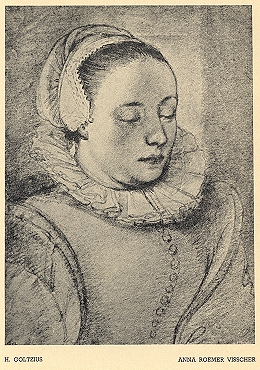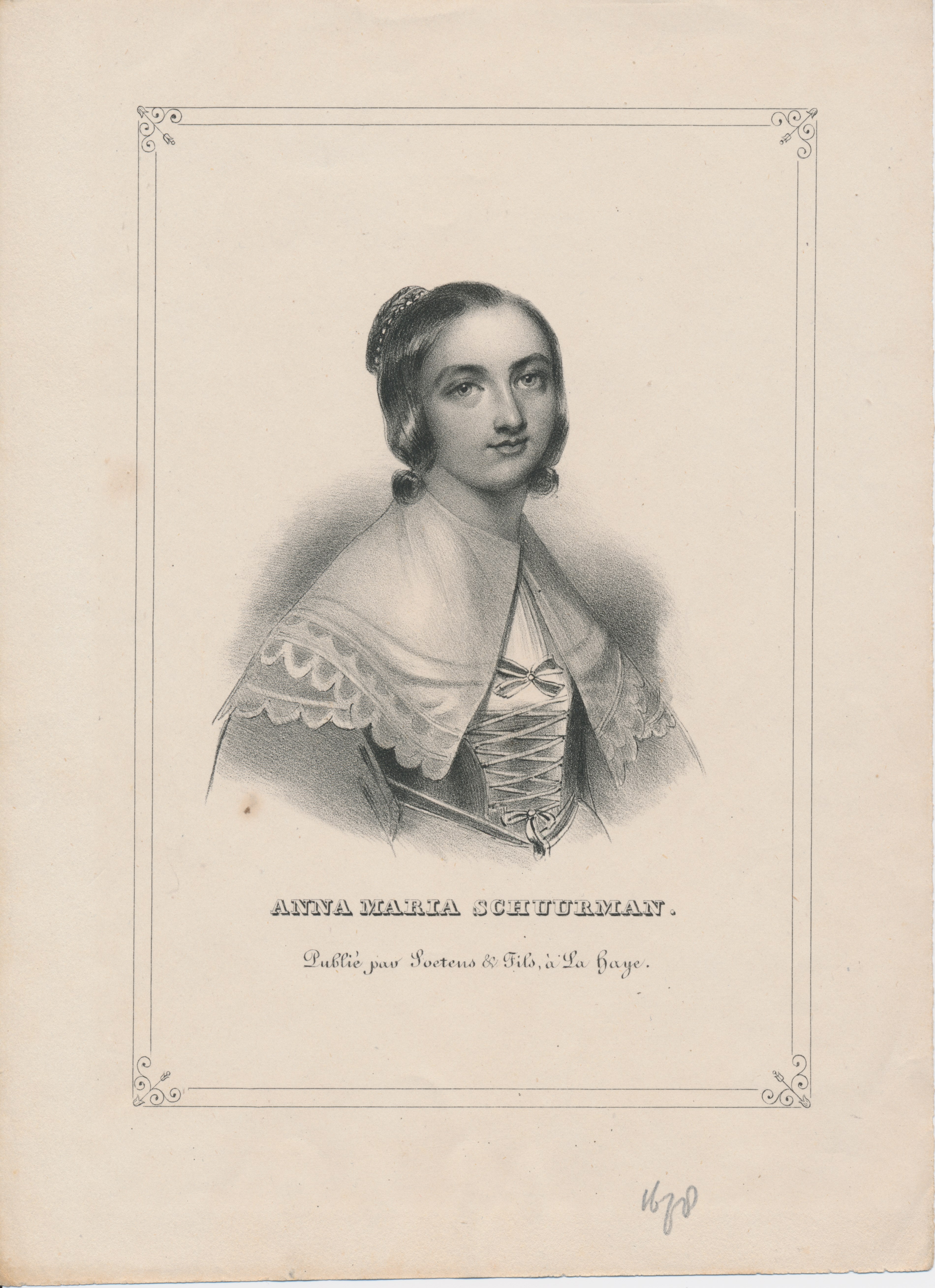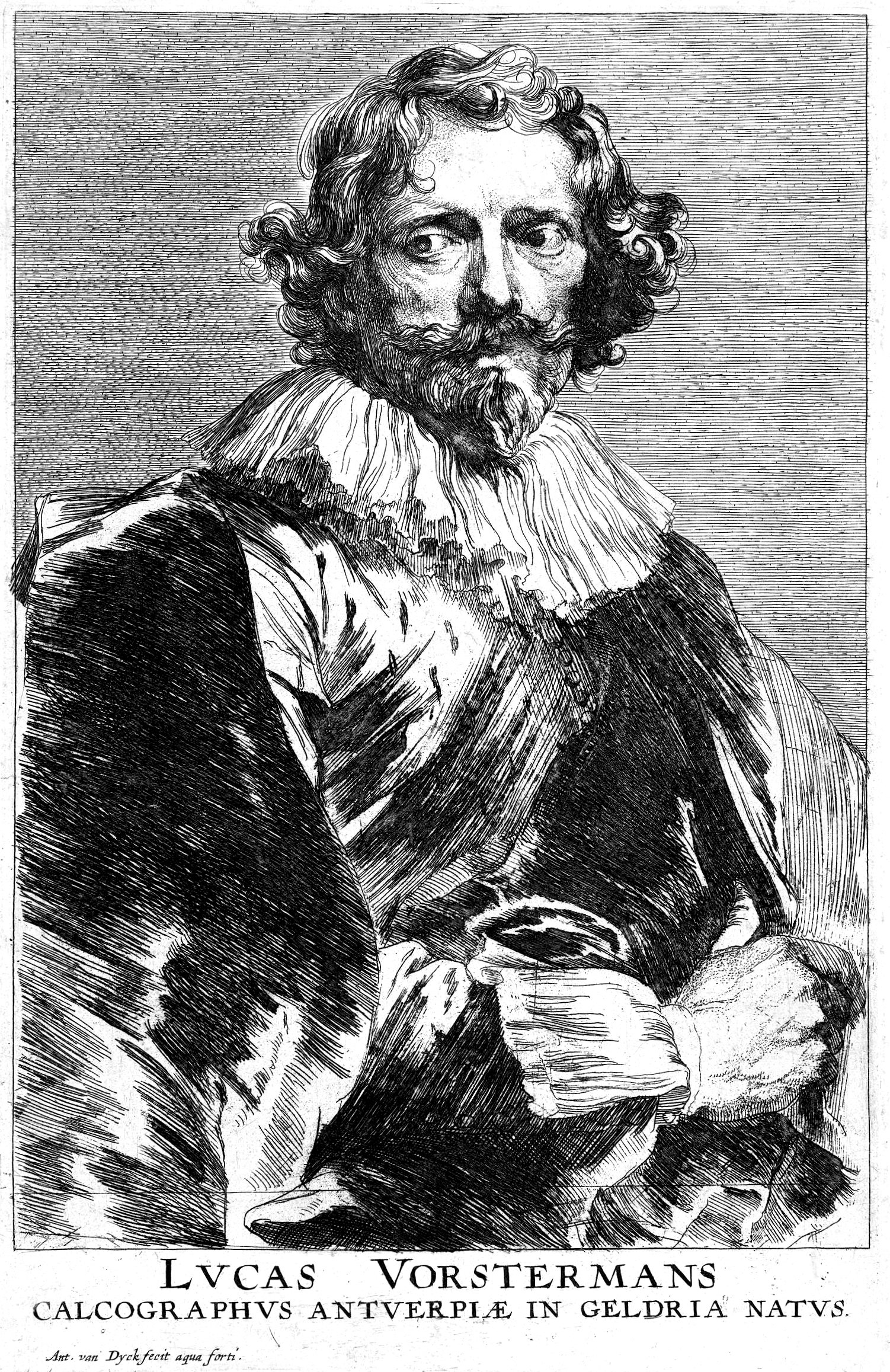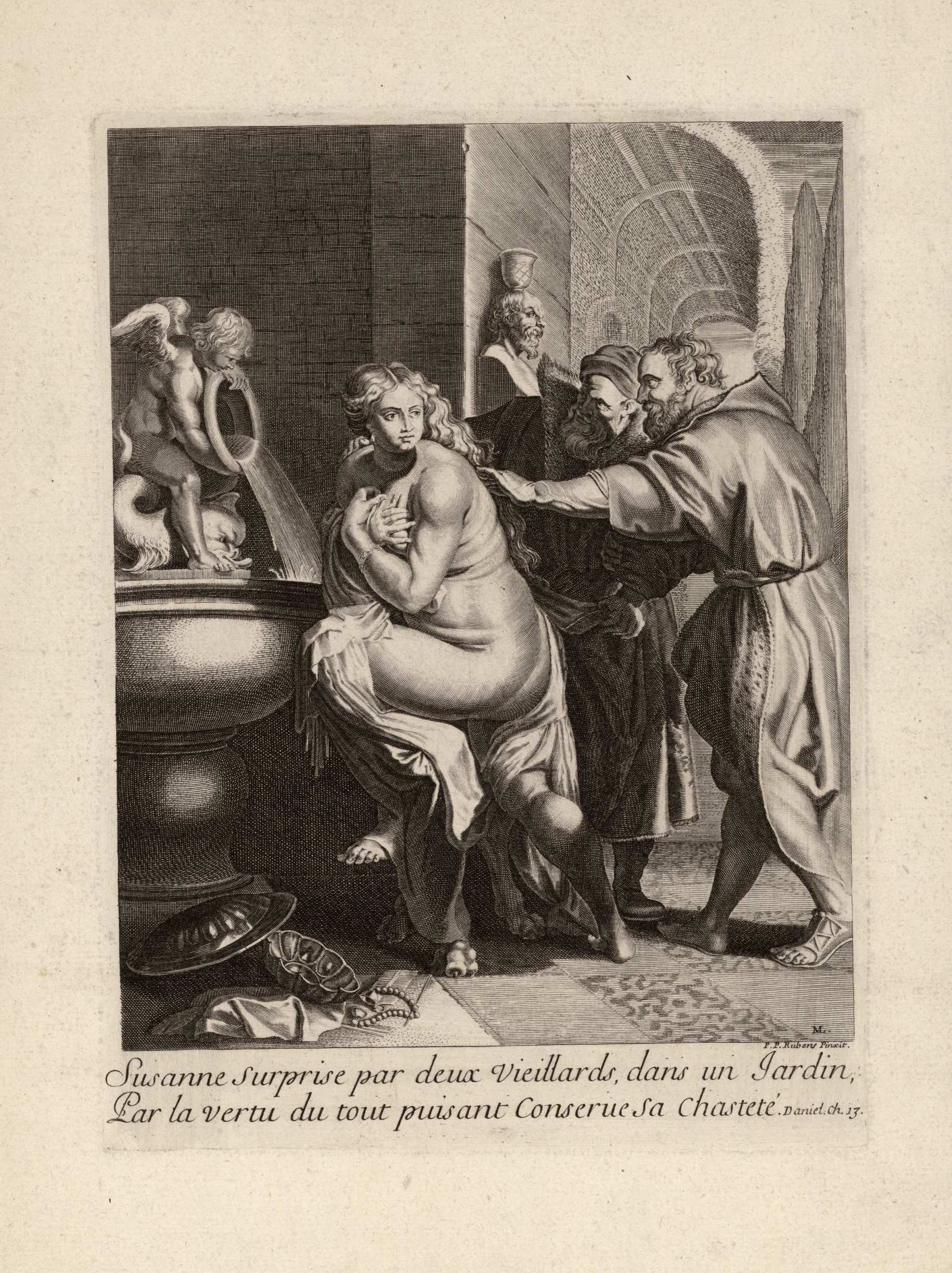|
Anna Roemers Visscher
Anna Roemers Visscher (c. 2 February 1583 – 6 December 1651) was a Dutch artist, poet, and translator. Biography Anna Roemers Visscher was the eldest daughter of Amsterdam merchant and poet Roemer Visscher and the sister of Maria Tesselschade Visscher. Her family's economic and social status in Amsterdam enabled Visscher to be schooled in languages, calligraphy, embroidery, drawing, painting, glass engraving and other arts. Visscher married Dominicus Booth van Wesel in 1624. In 1646, they moved with their two sons Roemer and Johan to Leiden. Visscher lived during the Renaissance when women poets were often praised for who they were more than for their literary work. She was amongst the group of artists, writers and musicians who formed the Muiderkring or Muiden Circle. She was highly admired by the artistic elite such as P. C. Hooft, Jacob Cats, Joost van den Vondel, Constantijn Huygens and others. They called her a muse, the second Sappho, a fourth grace and more, and often ... [...More Info...] [...Related Items...] OR: [Wikipedia] [Google] [Baidu] |
Dutch People
The Dutch (Dutch: ) are an ethnic group and nation native to the Netherlands. They share a common history and culture and speak the Dutch language. Dutch people and their descendants are found in migrant communities worldwide, notably in Aruba, Suriname, Guyana, Curaçao, Argentina, Brazil, Canada,Based on Statistics Canada, Canada 2001 Censusbr>Linkto Canadian statistics. Australia, South Africa, New Zealand and the United States.According tFactfinder.census.gov The Low Countries were situated around the border of France and the Holy Roman Empire, forming a part of their respective peripheries and the various territories of which they consisted had become virtually autonomous by the 13th century. Under the Habsburgs, the Netherlands were organised into a single administrative unit, and in the 16th and 17th centuries the Northern Netherlands gained independence from Spain as the Dutch Republic. The high degree of urbanization characteristic of Dutch society was attained at a ... [...More Info...] [...Related Items...] OR: [Wikipedia] [Google] [Baidu] |
Muiderkring
The Muiderkring (Muiden Circle) was the name given to a group of figures in the arts and sciences who regularly met at the castle of Muiden near Amsterdam during the first half of the 17th century, or the Golden Age of the Dutch Republic. The central figure of the Muiderkring was the poet Pieter Corneliszoon Hooft; Constantijn Huygens, Dirck Sweelinck, Vondel, Bredero and the poet sisters Anna Visscher and Maria Tesselschade Visscher were also considered part of the group.Paul Zumthor ''Daily Life in Rembrandt's Holland'' 1994 p218 "Hooft once wrote Maria a long letter consisting entirely of mythological allusions, just to inform her that she had left her slippers at his house. But the Muiden circle was something more than a mere symbol of literary preciosity,.." Some of the music connected with the circle was recorded by the Utrecht Utrecht ( , , ) is the List of cities in the Netherlands by province, fourth-largest city and a List of municipalities of the Netherlands, mun ... [...More Info...] [...Related Items...] OR: [Wikipedia] [Google] [Baidu] |
Anna Maria Van Schurman
Anna Maria van Schurman (November 5, 1607 – May 4, 1678) was a Dutch painter, engraver, poet, and scholar, who is best known for her exceptional learning and her defence of female education. She was a highly educated woman, who excelled in art, music, and literature, and became proficient in fourteen languages, including Latin, Greek, Hebrew, Arabic, Syriac, Aramaic, and Ethiopic, as well as various contemporary European languages. She was the first woman to unofficially study at a Dutch university. Life Van Schurman was born in Cologne, a daughter of wealthy parents, Frederik van Schurman, from Antwerp (d. 1623) and Eva von Harff de Dreiborn. At four years old she could read. When she was six, she had mastered creating highly intricate paper cut-outs that surpassed every other child her age. At the age of ten, she learned embroidery in three hours. In some of her writings, she talks about how she invented the technique of sculpting in wax, saying, "I had to discover ma ... [...More Info...] [...Related Items...] OR: [Wikipedia] [Google] [Baidu] |
Georgette De Montenay
Georgette de Montenay (1540–1581) was the French author of ''Emblemes ou devises chrestiennes'', published in Lyon between 1567 and 1571. Montenay has always been regarded as a lady-in-waiting to Jeanne d'Albret, the Protestant Queen of Navarre, partly because she dedicated her work to the Queen. An intriguing aspect of Montenay's Calvinist life is that she was married in 1562 to Guyon de Gout, a devout Catholic. Montenay was born in Toulouse. She came from an affluent military family, but was orphaned when young and was taken into the court by the Queen of Navarre, whom she served first as ''fille d'honneur'' and later as ''dame d'honneur''. Her position enabled her to acquire a thorough grounding in the classics and exposed her to Evangelism. She died at Sainte-Germier, near Toulouse. ''Emblemes ou Devises Chrestiennes'' Montenay's book is an important milestone in the history of emblem books, inasmuch as it was written by a female member of the Reformed (Calvinist) faith. ... [...More Info...] [...Related Items...] OR: [Wikipedia] [Google] [Baidu] |
Epigrams
An epigram is a brief, interesting, memorable, and sometimes surprising or satirical statement. The word is derived from the Greek "inscription" from "to write on, to inscribe", and the literary device has been employed for over two millennia. The presence of wit or sarcasm tends to distinguish non-poetic epigrams from aphorisms and adages, which tend to lack those qualities. Ancient Greek The Greek tradition of epigrams began as poems inscribed on votive offerings at sanctuariesincluding statues of athletesand on funerary monuments, for example "Go tell it to the Spartans, passersby...". These original epigrams did the same job as a short prose text might have done, but in verse. Epigram became a literary genre in the Hellenistic period, probably developing out of scholarly collections of inscriptional epigrams. Though modern epigrams are usually thought of as very short, Greek literary epigram was not always as short as later examples, and the divide between "epigr ... [...More Info...] [...Related Items...] OR: [Wikipedia] [Google] [Baidu] |
Emblem Book
An emblem book is a book collecting emblems (allegorical illustrations) with accompanying explanatory text, typically morals or poems. This category of books was popular in Europe during the 16th and 17th centuries. Emblem books are collections of sets of three elements: an icon or image, a motto, and text explaining the connection between the image and motto. The text ranged in length from a few lines of verse to pages of prose. Emblem books descended from medieval bestiaries that explained the importance of animals, proverbs, and fables. In fact, writers often drew inspiration from Greek and Roman sources such as Aesop's Fables and Plutarch's Lives. Definition Scholars differ on the key question of whether the actual emblems in question are the visual images, the accompanying texts, or the combination of the two. This is understandable, given that first emblem book, the ''Emblemata'' of Andrea Alciato, was first issued in an unauthorized edition in which the woodcuts were ... [...More Info...] [...Related Items...] OR: [Wikipedia] [Google] [Baidu] |
Lucas Vorsterman
Lucas Vorsterman (1595–1675) was a Baroque engraver. He worked with the artists Peter Paul Rubens and Anthony van Dyck, as well as for patrons such as Thomas Howard, 21st Earl of Arundel and Charles I of England. Biography Vorsterman was born in Zaltbommel. Around 1618, Vorsterman joined Rubens' workshop. Between 1619 and 1621, Vorsterman was Rubens's sole engraver. At that time, Rubens had embarked upon a printmaking enterprise in which he enlisted Vorsterman to engrave a number of his notable paintings, to which Rubens appended personal and professional dedications to noteworthy individuals. In 1621, a violent dispute arose between Vorsterman and Rubens. It is not clear whether there was a physical altercation between the two men, but the situation was sufficiently serious for Rubens' lawyers to petition the authorities for a protection order, which was granted. The exact causes of the dispute are not known, but it has generally been assumed that its source was in the ... [...More Info...] [...Related Items...] OR: [Wikipedia] [Google] [Baidu] |
Michel Lasne
Michel Lasne (Caen, ca. 1590–4 December 1667, Paris), was a French engraver, draughtsman and collector. Lasne was born in Caen and was the son of a goldsmith. He was a member of the Guild of Saint Luke in Antwerp for 1617–18, and probably worked under the direction of Peter Paul Rubens and Anthony van Dyck. At that time he made an engraving of Rubens's now-lost ''Susanna and the Elders'', which contains a dedication from Rubens to the Dutch humanist Anna Roemers Visscher. Lasne was in Paris by 1621, and in 1633 he became the official engraver for King Louis XIII. In France, Lasne engraved a number of portraits. There are at least 759 prints by Lasne, including 13 portraits of King Louis XIII and 10 of his wife, Anne of Austria. He made reproductive engravings after the French painters Philippe de Champaigne, Daniel Dumonstier, Simon Vouet, and Charles Le Brun; the Italian painters Paolo Veronese, Francesco Albani, and Titian; and the Spanish painter Jusepe de Ribera ... [...More Info...] [...Related Items...] OR: [Wikipedia] [Google] [Baidu] |
Peter Paul Rubens
Sir Peter Paul Rubens (; ; 28 June 1577 – 30 May 1640) was a Flemish artist and diplomat from the Duchy of Brabant in the Southern Netherlands (modern-day Belgium). He is considered the most influential artist of the Flemish Baroque tradition. Rubens's highly charged compositions reference erudite aspects of classical and Christian history. His unique and immensely popular Baroque style emphasized movement, colour, and sensuality, which followed the immediate, dramatic artistic style promoted in the Counter-Reformation. Rubens was a painter producing altarpieces, portraits, landscapes, and history paintings of mythological and allegorical subjects. He was also a prolific designer of cartoons for the Flemish tapestry workshops and of frontispieces for the publishers in Antwerp. In addition to running a large workshop in Antwerp that produced paintings popular with nobility and art collectors throughout Europe, Rubens was a classically educated humanist scholar and diploma ... [...More Info...] [...Related Items...] OR: [Wikipedia] [Google] [Baidu] |
Flanders
Flanders (, ; Dutch: ''Vlaanderen'' ) is the Flemish-speaking northern portion of Belgium and one of the communities, regions and language areas of Belgium. However, there are several overlapping definitions, including ones related to culture, language, politics, and history, and sometimes involving neighbouring countries. The demonym associated with Flanders is Fleming, while the corresponding adjective is Flemish. The official capital of Flanders is the City of Brussels, although the Brussels-Capital Region that includes it has an independent regional government. The powers of the government of Flanders consist, among others, of economic affairs in the Flemish Region and the community aspects of Flanders life in Brussels, such as Flemish culture and education. Geographically, Flanders is mainly flat, and has a small section of coast on the North Sea. It borders the French department of Nord to the south-west near the coast, the Dutch provinces of Zeeland, North Brabant an ... [...More Info...] [...Related Items...] OR: [Wikipedia] [Google] [Baidu] |
Sappho
Sappho (; el, Σαπφώ ''Sapphō'' ; Aeolic Greek ''Psápphō''; c. 630 – c. 570 BC) was an Archaic Greek poet from Eresos or Mytilene on the island of Lesbos. Sappho is known for her Greek lyric, lyric poetry, written to be sung while accompanied by music. In ancient times, Sappho was widely regarded as one of the greatest lyric poets and was given names such as the "Tenth Muse" and "The Poetess". Most of Poetry of Sappho, Sappho's poetry is now lost, and what is extant has mostly survived in fragmentary form; only the "Ode to Aphrodite" is certainly complete. As well as lyric poetry, ancient commentators claimed that Sappho wrote elegiac and iambic poetry. Three epigrams attributed to Sappho are extant, but these are actually Hellenistic imitations of Sappho's style. Little is known of Sappho's life. She was from a wealthy family from Lesbos, though her parents' names are uncertain. Ancient sources say that she had three brothers; Charaxos (Χάραξος), Larichos ( ... [...More Info...] [...Related Items...] OR: [Wikipedia] [Google] [Baidu] |
Constantijn Huygens
Sir Constantijn Huygens, Lord of Zuilichem ( , , ; 4 September 159628 March 1687), was a Dutch Golden Age poet and composer. He was also secretary to two Princes of Orange: Frederick Henry and William II, and the father of the scientist Christiaan Huygens. Biography Constantijn Huygens was born in The Hague, the second son of Christiaan Huygens (senior), secretary of the Council of State, and Susanna Hoefnagel, niece of the Antwerp painter Joris Hoefnagel. Education Constantijn was a gifted child in his youth. His brother Maurits and he were educated partly by their father and partly by carefully instructed governors. When he was five years old, Constantijn and his brother received their first musical education. Music education They started with singing lessons, and they learned their notes using gold-coloured buttons on their jackets. It is striking that Christiaan senior imparted the "modern" system of 7 note names to the boys, instead of the traditional, but much mor ... [...More Info...] [...Related Items...] OR: [Wikipedia] [Google] [Baidu] |



_(cropped).jpg)





